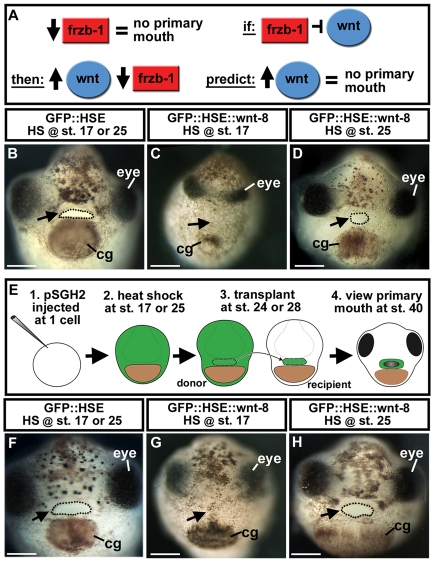Fig. 4.
Temporal and spatial overexpression of wnt-8 under control of a heat-shock promoter element (HSE) and using ectoderm transplants. Frontal views are shown, assayed at stage 40 in two to three independent experiments. Open primary mouth, black dotted line; cg, cement gland; pSGH2, ISceI-GFP-HSE plasmid. Arrows indicate the primary mouth or region where it would form. Scale bars: 250 μm. (A) Schematic showing prediction that if Frzb-1/Cresent inhibits Wnt signaling, increased Wnt-8 would phenocopy loss of Frzb-1/Crescent. (B) Injected with GFP::HSE followed by heat shock at either stage 17 or 25 has no effect on primary mouth formation (90%, n=50). (C) Injection of GFP::HSE::wnt-8 and heat shock administered at stage 17 results in neither a stomodeum nor a primary mouth (97%, n=65). (D) Injection of GFP::HSE::wnt-8 and heat shock administered later (stage 25-28) results in a normal primary mouth (47%) or a slightly smaller one (53%, n=32). (E) Schematic of experimental design using ectoderm transplants. (F) Control (GFP::HSE): when heat shock was administered at stage 17 and transplants performed at stage 24, recipients form a primary mouth (100%, n=12). The same is true if heat shock is administered at stage 24 and transplants are performed at stage 28 (n=10). (G) GFP::HSE::wnt-8: when heat shock was administered at stage 17 and transplants performed at stage 24, 83% of the recipients do not form a stomodeum or a primary mouth (n=12). (H) When the experiment in G was performed later, 88% formed a normal primary mouth (n=9).

